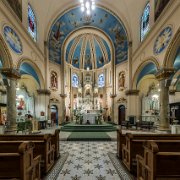
1 St. Hedwig's was the third Polish parish established on Detroit's west side. Bishop Foley appointed Father John Mueller pastor on July 3, 1902. St. Casmir's was the first Polish parish on the west side, founded in 1882—even before Sweetest Heart of Mary. And then St. Francis de Assisi was the second Polish parish on the west side established in 1889. As frequently happened in Detroit and elsewhere, Polish Catholics disagreed strongly with the bishop. St. Hedwig's Parish was dissolved in 1905 until a new group of priests more loyal to Detroit bishops—Polish Franciscans—were recruited to staff and manage St. Hedwig's Parish. Father Eustace Bartoszewicz was appointed pastor in 1912, and five years later, the magnificent church that you see was completed. Later, the parish established a large elementary school and then a high school that survived for 49 years until the out-migration of Poles and others from this neighborhood led to its closing. The elementary school closed five years later. Perhaps surprisingly, this neighborhood became a destination point for newly-arriving immigrants from Mexico. The priests of the parish, rather than offering Mass in Polish as they did a century ago, now serve the needs of their Spanish-speaking parishioners. Interestingly, the parish school is still an educational facility now managed by the city's public school system and offering instruction to Spanish-speaking students.
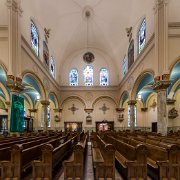
2 St. Hedwig's was the third Polish parish established on Detroit's west side. Bishop Foley appointed Father John Mueller pastor on July 3, 1902. St. Casmir's was the first Polish parish on the west side, founded in 1882—even before Sweetest Heart of Mary. And then St. Francis de Assisi was the second Polish parish on the west side established in 1889. As frequently happened in Detroit and elsewhere, Polish Catholics disagreed strongly with the bishop. St. Hedwig's Parish was dissolved in 1905 until a new group of priests more loyal to Detroit bishops—Polish Franciscans—were recruited to staff and manage St. Hedwig's Parish. Father Eustace Bartoszewicz was appointed pastor in 1912, and five years later, the magnificent church that you see was completed. Later, the parish established a large elementary school and then a high school that survived for 49 years until the out-migration of Poles and others from this neighborhood led to its closing. The elementary school closed five years later. Perhaps surprisingly, this neighborhood became a destination point for newly-arriving immigrants from Mexico. The priests of the parish, rather than offering Mass in Polish as they did a century ago, now serve the needs of their Spanish-speaking parishioners. Interestingly, the parish school is still an educational facility now managed by the city's public school system and offering instruction to Spanish-speaking students.
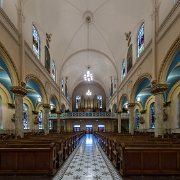
3 St. Hedwig's was the third Polish parish established on Detroit's west side. Bishop Foley appointed Father John Mueller pastor on July 3, 1902. St. Casmir's was the first Polish parish on the west side, founded in 1882—even before Sweetest Heart of Mary. And then St. Francis de Assisi was the second Polish parish on the west side established in 1889. As frequently happened in Detroit and elsewhere, Polish Catholics disagreed strongly with the bishop. St. Hedwig's Parish was dissolved in 1905 until a new group of priests more loyal to Detroit bishops—Polish Franciscans—were recruited to staff and manage St. Hedwig's Parish. Father Eustace Bartoszewicz was appointed pastor in 1912, and five years later, the magnificent church that you see was completed. Later, the parish established a large elementary school and then a high school that survived for 49 years until the out-migration of Poles and others from this neighborhood led to its closing. The elementary school closed five years later. Perhaps surprisingly, this neighborhood became a destination point for newly-arriving immigrants from Mexico. The priests of the parish, rather than offering Mass in Polish as they did a century ago, now serve the needs of their Spanish-speaking parishioners. Interestingly, the parish school is still an educational facility now managed by the city's public school system and offering instruction to Spanish-speaking students.
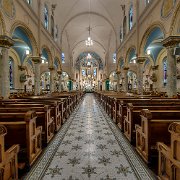
4 St. Hedwig's was the third Polish parish established on Detroit's west side. Bishop Foley appointed Father John Mueller pastor on July 3, 1902. St. Casmir's was the first Polish parish on the west side, founded in 1882—even before Sweetest Heart of Mary. And then St. Francis de Assisi was the second Polish parish on the west side established in 1889. As frequently happened in Detroit and elsewhere, Polish Catholics disagreed strongly with the bishop. St. Hedwig's Parish was dissolved in 1905 until a new group of priests more loyal to Detroit bishops—Polish Franciscans—were recruited to staff and manage St. Hedwig's Parish. Father Eustace Bartoszewicz was appointed pastor in 1912, and five years later, the magnificent church that you see was completed. Later, the parish established a large elementary school and then a high school that survived for 49 years until the out-migration of Poles and others from this neighborhood led to its closing. The elementary school closed five years later. Perhaps surprisingly, this neighborhood became a destination point for newly-arriving immigrants from Mexico. The priests of the parish, rather than offering Mass in Polish as they did a century ago, now serve the needs of their Spanish-speaking parishioners. Interestingly, the parish school is still an educational facility now managed by the city's public school system and offering instruction to Spanish-speaking students.
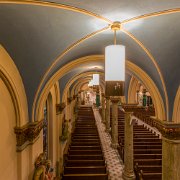
5 St. Hedwig's was the third Polish parish established on Detroit's west side. Bishop Foley appointed Father John Mueller pastor on July 3, 1902. St. Casmir's was the first Polish parish on the west side, founded in 1882—even before Sweetest Heart of Mary. And then St. Francis de Assisi was the second Polish parish on the west side established in 1889. As frequently happened in Detroit and elsewhere, Polish Catholics disagreed strongly with the bishop. St. Hedwig's Parish was dissolved in 1905 until a new group of priests more loyal to Detroit bishops—Polish Franciscans—were recruited to staff and manage St. Hedwig's Parish. Father Eustace Bartoszewicz was appointed pastor in 1912, and five years later, the magnificent church that you see was completed. Later, the parish established a large elementary school and then a high school that survived for 49 years until the out-migration of Poles and others from this neighborhood led to its closing. The elementary school closed five years later. Perhaps surprisingly, this neighborhood became a destination point for newly-arriving immigrants from Mexico. The priests of the parish, rather than offering Mass in Polish as they did a century ago, now serve the needs of their Spanish-speaking parishioners. Interestingly, the parish school is still an educational facility now managed by the city's public school system and offering instruction to Spanish-speaking students.
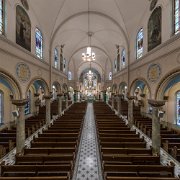
6 St. Hedwig's was the third Polish parish established on Detroit's west side. Bishop Foley appointed Father John Mueller pastor on July 3, 1902. St. Casmir's was the first Polish parish on the west side, founded in 1882—even before Sweetest Heart of Mary. And then St. Francis de Assisi was the second Polish parish on the west side established in 1889. As frequently happened in Detroit and elsewhere, Polish Catholics disagreed strongly with the bishop. St. Hedwig's Parish was dissolved in 1905 until a new group of priests more loyal to Detroit bishops—Polish Franciscans—were recruited to staff and manage St. Hedwig's Parish. Father Eustace Bartoszewicz was appointed pastor in 1912, and five years later, the magnificent church that you see was completed. Later, the parish established a large elementary school and then a high school that survived for 49 years until the out-migration of Poles and others from this neighborhood led to its closing. The elementary school closed five years later. Perhaps surprisingly, this neighborhood became a destination point for newly-arriving immigrants from Mexico. The priests of the parish, rather than offering Mass in Polish as they did a century ago, now serve the needs of their Spanish-speaking parishioners. Interestingly, the parish school is still an educational facility now managed by the city's public school system and offering instruction to Spanish-speaking students.
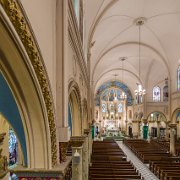
7 St. Hedwig's was the third Polish parish established on Detroit's west side. Bishop Foley appointed Father John Mueller pastor on July 3, 1902. St. Casmir's was the first Polish parish on the west side, founded in 1882—even before Sweetest Heart of Mary. And then St. Francis de Assisi was the second Polish parish on the west side established in 1889. As frequently happened in Detroit and elsewhere, Polish Catholics disagreed strongly with the bishop. St. Hedwig's Parish was dissolved in 1905 until a new group of priests more loyal to Detroit bishops—Polish Franciscans—were recruited to staff and manage St. Hedwig's Parish. Father Eustace Bartoszewicz was appointed pastor in 1912, and five years later, the magnificent church that you see was completed. Later, the parish established a large elementary school and then a high school that survived for 49 years until the out-migration of Poles and others from this neighborhood led to its closing. The elementary school closed five years later. Perhaps surprisingly, this neighborhood became a destination point for newly-arriving immigrants from Mexico. The priests of the parish, rather than offering Mass in Polish as they did a century ago, now serve the needs of their Spanish-speaking parishioners. Interestingly, the parish school is still an educational facility now managed by the city's public school system and offering instruction to Spanish-speaking students.
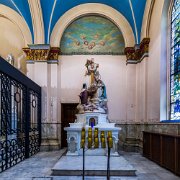
8 St. Hedwig's was the third Polish parish established on Detroit's west side. Bishop Foley appointed Father John Mueller pastor on July 3, 1902. St. Casmir's was the first Polish parish on the west side, founded in 1882—even before Sweetest Heart of Mary. And then St. Francis de Assisi was the second Polish parish on the west side established in 1889. As frequently happened in Detroit and elsewhere, Polish Catholics disagreed strongly with the bishop. St. Hedwig's Parish was dissolved in 1905 until a new group of priests more loyal to Detroit bishops—Polish Franciscans—were recruited to staff and manage St. Hedwig's Parish. Father Eustace Bartoszewicz was appointed pastor in 1912, and five years later, the magnificent church that you see was completed. Later, the parish established a large elementary school and then a high school that survived for 49 years until the out-migration of Poles and others from this neighborhood led to its closing. The elementary school closed five years later. Perhaps surprisingly, this neighborhood became a destination point for newly-arriving immigrants from Mexico. The priests of the parish, rather than offering Mass in Polish as they did a century ago, now serve the needs of their Spanish-speaking parishioners. Interestingly, the parish school is still an educational facility now managed by the city's public school system and offering instruction to Spanish-speaking students.
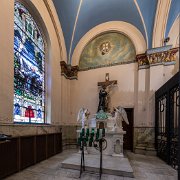
9 St. Hedwig's was the third Polish parish established on Detroit's west side. Bishop Foley appointed Father John Mueller pastor on July 3, 1902. St. Casmir's was the first Polish parish on the west side, founded in 1882—even before Sweetest Heart of Mary. And then St. Francis de Assisi was the second Polish parish on the west side established in 1889. As frequently happened in Detroit and elsewhere, Polish Catholics disagreed strongly with the bishop. St. Hedwig's Parish was dissolved in 1905 until a new group of priests more loyal to Detroit bishops—Polish Franciscans—were recruited to staff and manage St. Hedwig's Parish. Father Eustace Bartoszewicz was appointed pastor in 1912, and five years later, the magnificent church that you see was completed. Later, the parish established a large elementary school and then a high school that survived for 49 years until the out-migration of Poles and others from this neighborhood led to its closing. The elementary school closed five years later. Perhaps surprisingly, this neighborhood became a destination point for newly-arriving immigrants from Mexico. The priests of the parish, rather than offering Mass in Polish as they did a century ago, now serve the needs of their Spanish-speaking parishioners. Interestingly, the parish school is still an educational facility now managed by the city's public school system and offering instruction to Spanish-speaking students.
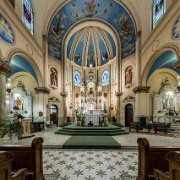
10 St. Hedwig's was the third Polish parish established on Detroit's west side. Bishop Foley appointed Father John Mueller pastor on July 3, 1902. St. Casmir's was the first Polish parish on the west side, founded in 1882—even before Sweetest Heart of Mary. And then St. Francis de Assisi was the second Polish parish on the west side established in 1889. As frequently happened in Detroit and elsewhere, Polish Catholics disagreed strongly with the bishop. St. Hedwig's Parish was dissolved in 1905 until a new group of priests more loyal to Detroit bishops—Polish Franciscans—were recruited to staff and manage St. Hedwig's Parish. Father Eustace Bartoszewicz was appointed pastor in 1912, and five years later, the magnificent church that you see was completed. Later, the parish established a large elementary school and then a high school that survived for 49 years until the out-migration of Poles and others from this neighborhood led to its closing. The elementary school closed five years later. Perhaps surprisingly, this neighborhood became a destination point for newly-arriving immigrants from Mexico. The priests of the parish, rather than offering Mass in Polish as they did a century ago, now serve the needs of their Spanish-speaking parishioners. Interestingly, the parish school is still an educational facility now managed by the city's public school system and offering instruction to Spanish-speaking students.
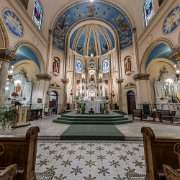
11 St. Hedwig's was the third Polish parish established on Detroit's west side. Bishop Foley appointed Father John Mueller pastor on July 3, 1902. St. Casmir's was the first Polish parish on the west side, founded in 1882—even before Sweetest Heart of Mary. And then St. Francis de Assisi was the second Polish parish on the west side established in 1889. As frequently happened in Detroit and elsewhere, Polish Catholics disagreed strongly with the bishop. St. Hedwig's Parish was dissolved in 1905 until a new group of priests more loyal to Detroit bishops—Polish Franciscans—were recruited to staff and manage St. Hedwig's Parish. Father Eustace Bartoszewicz was appointed pastor in 1912, and five years later, the magnificent church that you see was completed. Later, the parish established a large elementary school and then a high school that survived for 49 years until the out-migration of Poles and others from this neighborhood led to its closing. The elementary school closed five years later. Perhaps surprisingly, this neighborhood became a destination point for newly-arriving immigrants from Mexico. The priests of the parish, rather than offering Mass in Polish as they did a century ago, now serve the needs of their Spanish-speaking parishioners. Interestingly, the parish school is still an educational facility now managed by the city's public school system and offering instruction to Spanish-speaking students.
St. Hedwig Catholic Church